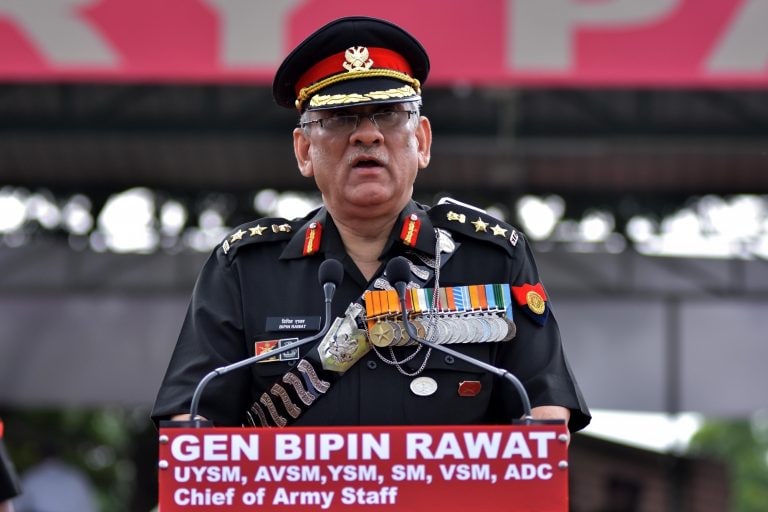
SOURCE : PTI
Chief of Defence Staff Gen Bipin Rawat on Wednesday called for revamping India’s defence public sector undertakings and ordnance factories with a focus on improving their work culture and enhancing quality control.
Gen Rawat also said that some of India’s vintage military platforms, with retrofits, can be exported to countries that lack the desired firepower to defend themselves.
Addressing a seminar on defence exports, the Chief of Defence Staff also pitched for having a “hard look” at the distribution of India’s defence expenditure, saying a realistic analysis of the spending must be carried out for proper utilisation of resources.
Gen Rawat said India must move out of constant “threat of sanctions” or dependence on individual nations for its military requirements, in an apparent reference to difficulties involved in the procurement of equipment from countries facing sanctions.
In October 2018, India had signed a USD five-billion deal with Russia to buy five units of the S-400 air defence missile systems, notwithstanding a warning from the Trump administration that going ahead with the contract may invite US sanctions.
The US had imposed sanctions on Russia under the stringent Countering America’s Adversaries Through Sanctions Act (CAATSA). The law also provides for punitive action against countries purchasing defence hardware from Russia.
Gen Rawat said the stage is set for the domestic industry to embark on a trajectory of exponential growth, riding on path-breaking reforms rolled out by the government to promote indigenous production of military assets.
“We need to revamp our ordnance factories and other defence public sector undertakings in terms of modernisation, their work culture and quality control.
“Corporatisation including the public listing of some units would be a way forward to ensure a more efficient interface with the designer end-user,” he said at the seminar organised by industry chamber FICCI.
India’s DPSUs include aerospace major Hindustan Aeronautics Limited (HAL), Bharat Electronics Ltd (BEL), Bharat Dynamics Ltd (BDL), Mazagon Dock Shipbuilders Limited (MDL), Garden Reach Shipbuilders and Engineers Ltd (GRSE), Goa Shipyard Limited (GSL), Bharat Earth Movers Ltd (BEML) and Mishra Dhatu Nigam Ltd (MIDHANI).
The HAL, which produces a range of aircraft and helicopters, is the largest DPSU. Most of the DPSUs have been awarded the prestigious status of ‘Navratna’ or Mini Ratna because of their consistently high level of performance.
He said the armed forces are committed to win India’s wars with indigenous solutions.
Gen Rawat said some of India’s vintage military platforms can be exported.
“Our current military fleet comprises of a fair share of vintage platforms which are under modernisation plans in the coming decades. These vintage platforms, with some retrofits or perhaps as it is, could be exported to countries which lack desired firepower to defend themselves,” he said.
“We may also consider sharing vintage platforms with domestic industry to assist them in developing cutting edge technology,” he said at the seminar.
The Chief of Defence Staff urged the private industry to invest in building long-term capabilities for the application of decisive military power.
In the last three years, he said, India witnessed a staggering 700 per cent growth in defence exports from Rs 1500 crore in 2016-17 to Rs 10,745 crore in 2018-19.
“India is the third-largest defence spender in the world. It is time to have a hard look at the distribution of our defence expenditure. We must carry out a realistic analysis of our expenditures,” he added
“The statement of being third largest spender must give us the capabilities we desire to achieve which is not the case at present,” he said.
In the last few months, the government has unveiled a series of reform measures and initiatives to make India a hub of defence manufacturing.
Last month, Defence Minister Rajnath Singh announced that India will stop the import of 101 weapons and military platforms like transport aircraft, light combat helicopters, conventional submarines, cruise missiles and sonar systems by 2024.
In May, the government announced increasing the FDI limit from 49 per cent to 74 per cent under the automatic route in the defence sector.
India is one of the largest importers of arms globally. According to estimates, the Indian armed forces are projected to spend around USD 130 billion in capital procurement in the next five years.
The government now wants to reduce dependence on imported military platforms and has decided to support the domestic defence manufacturing.The defence ministry has set a goal of a turnover of USD 25 billion (Rs 1.75 lakh crore) in defence manufacturing in the next five years that include an export target of USD 5 billion (Rs 35,000 crore) worth of military hardware.






